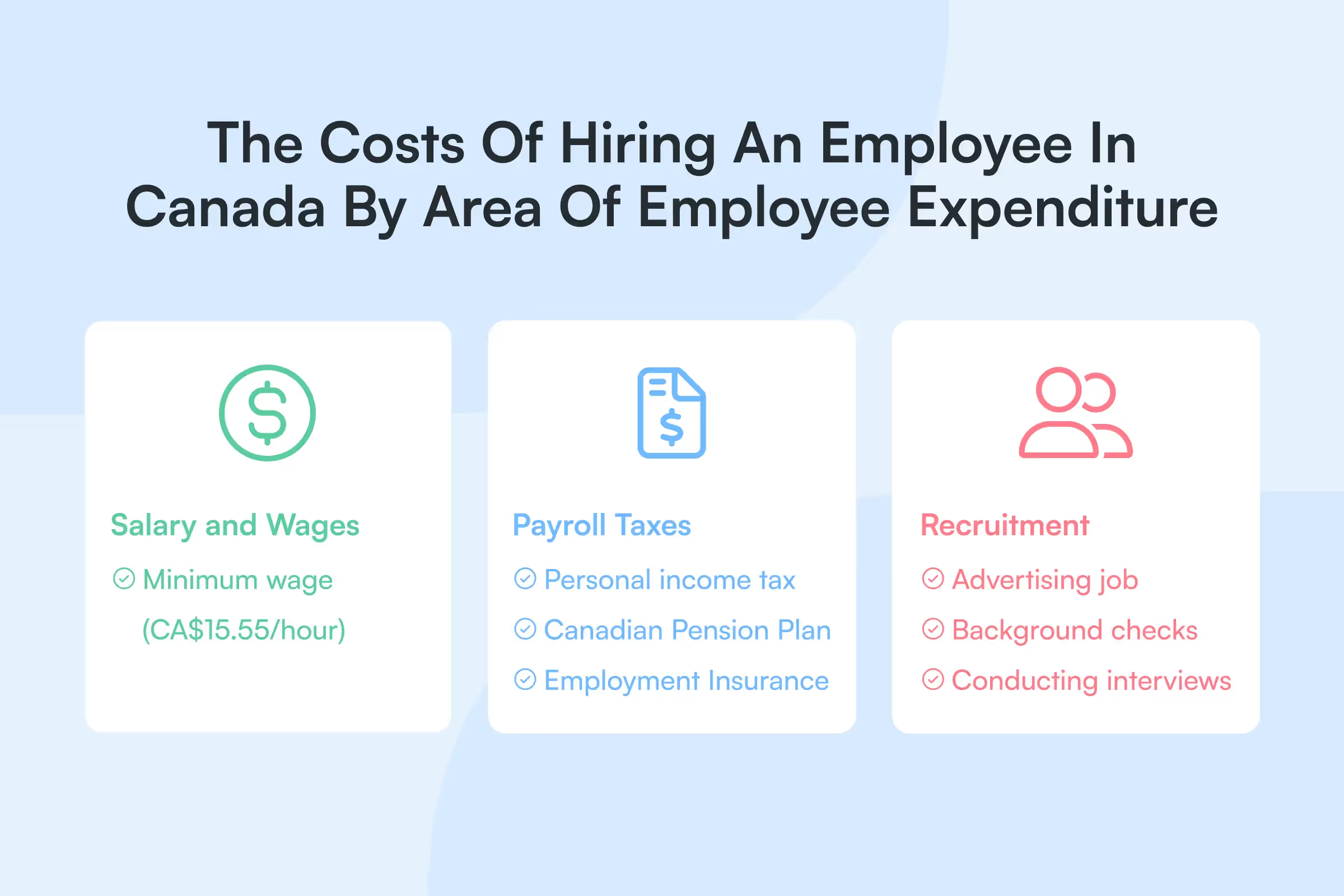International hiring has become a must for many companies, allowing them to access top talents and explore new markets. This approach infuses fresh perspectives and keeps operations running around the clock.
Establishing a workforce from different countries can boost a company's reputation and help with tricky regulations and partnerships. It is worth noting that many businesses keen on expanding their reach frequently set their sights on Canada, for several compelling reasons.
Hiring employees in Canada is considered a smart business choice due to its highly sought-after talent pool, thanks to its renowned education system and linguistic diversity. Their immigration policies are also designed to attract talented people from around the world, making it easier for businesses to secure the workforce they need. Canada’s close ties with the United States further enhance its economic appeal.
With a welcoming environment and business-friendly policies, Canada emerges as a strategic hub for companies eager to tap into fresh market opportunities. This naturally gives rise to a series of probing questions: in Canada, how much does an employee cost? And how much does an employee cost on top of salary?
It’s crucial to know that employee cost associated with hiring in Canada revolves around the basic salary or wages, closely trailed by the broader category of compensation and benefits. Beyond the paycheck, an employer's expenditure encompasses payroll taxes, the withholding of personal income taxes from an employee's earnings and the matching employer contributions that are deducted from their pay. For everything you need to know about employee costs in Canada, read on!
What is the Cost of an Employee in Canada?
If we look only at the payroll costs without factoring in things like employer contributions to CPP and EI (which are tax-deductible for businesses), it adds up to ≈30% of the employee's base salary. In simpler terms, hiring a Canadian employee typically means you're spending around 1.2 to 1.4 times their base salary when you take each actual cost into account.
Understanding these before you calculate employee costs will help you make smart money choices, plan for growth, and stay financially strong. This knowledge is key to managing employment expenses, anticipating an employee's total cost and ensuring long-term success in Canada.

The Costs of Hiring an Employee in Canada by Area of Employee Expenditure
When calculating employee costs in Canada, employers have many aspects to consider. We'll break down the different parts that make up the overall cost of an employee and general expenses for employers.
The true cost of an employee can include factors such as basic pay, tax details, health insurance, employee benefits, and extra costs, providing a clear picture of how complex employee spending can be in the Canadian context.
Employee Cost: Salary and Wages
Whether we're talking about getting paid by the hour or having a yearly salary, how much you make can change depending on where you are in Canada. Different provinces and territories have their own ways of dealing with compensation for labour costs.
Hence, it's safer to think of each place as unique when it comes to handling paychecks. General workers, often constituting the minimum wage workforce, typically receive compensation at a rate of CA$15.55 per hour.
Canadian employers may discover that hiring salaried workers in lower tax brackets is more budget-friendly than those in higher brackets. This is due to the federal tax system's relatively even distribution of tax percentages across five tax brackets. As a result, employers generally incur similar average hiring costs, with a slight reduction for lower-income employees and only a modest increase for higher-income ones.
Legal and Regulatory Compliance
When it comes to legal and regulatory compliance, Canadian employers often benefit from a more straightforward set of requirements, which can result in a lighter financial burden compared to the more intricate landscape of the United States.
Payroll Taxes
A Canadian employer’s payroll taxes include:
- Personal income tax withheld on an employee’s earnings at the federal and provincial level
- social security contributions are calculated as a percentage of an employee’s base salary in which a portion is employee-paid (taken out of their earnings) and employer-paid for: Canadian Pension Plan (CPP) and Employment Insurance (EI).
In the US, the Federal Insurance Contributions Act (FICA) and the Federal Unemployment Tax Act (FUTA) are part of the payroll tax obligations. These taxes play a significant role in funding social security and unemployment benefits.
On the other hand, Canada also has payroll tax obligations related to social security, with both employers and employees required to contribute a portion of the employee's salary. However, there's a distinction between the contributions for Employment Insurance (EI) and the Canada Pension Plan (CPP). Employers pay a higher percentage into the EI fund compared to what employees contribute. In contrast, both employers and employees pay the same rate to the CPP fund.
This difference in the contribution rates means that the actual dollar amount employers pay for EI is not identical to what employees pay. However, when it comes to the CPP, the contribution amounts are the same for both employers and employees.
EI provides essential financial support during temporary unemployment, while CPP serves as an employee's retirement savings scheme. These programs ensure financial stability in different phases of life.
Moreover, both federal and provincial income taxes play a crucial role in funding numerous social and economic initiatives that directly enhance the well-being of Canadian citizens. These initiatives encompass various essential services, such as healthcare, education, and infrastructure development.
Furthermore, employers have the opportunity to lower their overall costs of hiring by making contributions to health plans and group retirement plans, which are generally tax-deductible as legitimate business expenses. This not only reduces a company's corporate taxable income but also underscores the potential financial benefits for employers, making the prospect of hiring more appealing.
Recruitment
In Canada, recruiting new talent is a multifaceted process. This journey includes steps such as advertising job openings to attract potential candidates, reviewing resumes and conducting background checks to ensure the right fit for your team, and then proceeding to in-person interviews. These interviews offer a chance to sift through the talent pool and find the right candidates, evaluate their compatibility with your company culture, and assess their skills and enthusiasm for the job. These interconnected steps require time and resources, forming an essential investment in the quest to find the perfect individuals who will contribute to your company's growth.
Paid Time Off
In Canada, employees have access to various forms of paid time off to support their well-being and work-life balance. This includes annual vacation pay, which offers employees a paid break to recharge.
Moreover, there are different types of paid and unpaid leaves, like parental leave and bereavement leave, designed to assist employees during various life situations. Employees also enjoy paid time off on general holidays.
It's worth noting that these regulations typically apply to federally regulated employees, so it's essential to understand how they relate to your specific workplace. Canada provides a range of paid time off options to help employees manage their work and personal lives effectively.
Employer-Sponsored Health Insurance
Supplementary benefits usually make up about 15% of an employee's payroll. Mandatory healthcare isn't part of this because of Canada's robust publicly funded single-payer healthcare system. This system ensures that people have reliable access to essential healthcare services, which lowers the cost for employers when they hire new people.
Many competitive employers, however, go the extra mile by providing coverage for essential dental procedures, eye exams, and prescription drugs, among other benefits, to attract and retain top talent. These types of benefits are quite popular and appealing among employees.
Providing 100% coverage for essential services, up to certain limits, eases the financial load on employees and enhances their well-being and productivity. In some workplaces, employees also receive a one-time payout to choose a health or wellness service.
In 2021, the median amount for mental health benefits was CA $750, a highly appreciated employee perk. Even though the costs of offering these benefits have been on the rise, with the average cost per employee reaching CA $8,330 in 2015, it's considered a worthwhile, tax-deductible investment.
Group Registered Retirement Savings Plan (RRSP)
While the Canada Pension Plan (CPP) is a mandatory retirement benefit, many employers choose to offer additional retirement benefits like Group Registered Retirement Savings Plans (RRSP). Employees who participate in a Group RRSP usually contribute a small portion of their annual room, which is typically 18%.
There are other retirement arrangements available, such as Registered Pension Plans (RPP), Deferred Profit Sharing Plans (DPSP), and Group Tax-Free Savings Accounts (TFSA).
Employers can benefit from these arrangements by reducing their corporate taxable income through contributions, while employees can claim deductions on their personal income taxes the following year because employer contributions count as taxable income for the current year. It's a win-win for both employers and employees.
Additional Paid and Unpaid Leave
In Canada, many employers offer a mix of paid and unpaid leaves on top of the required ones, which workers greatly appreciate. These extra leaves can be used for things like parental or compassionate reasons. Some employers even provide weekly income replacement during these paid leaves, which can last for up to 18 weeks. It's a helpful benefit that encourages employees to take the time they need.
Additional Remuneration
Canadian employers often use equity-based compensation. While Incentive Stock Options (ISOs) are quite popular, they aren't considered a business expense because they come with tax advantages for employees and aren't tax-deductible for employers. Nonetheless, there's a strong argument that granting ISOs still represents a real cost to employers, making it part of the hiring expense. Another common choice is Restricted Stock Units (RSU).
Other Costs of Hiring a New Employee
Since investing in professional development is becoming increasingly common, employers are chipping in for their employees to learn new skills and knowledge. For instance, they might offer up to CA $1,000 for an employee's chosen education. It's a perk that's gaining popularity.
Companies are also helping employees by providing overhead costs and tools like company laptops and sometimes giving them a one-time payment to set up a remote work setup. Team-building events sponsored by the employer and, in some cases, covering business travel costs are additional expenses in the hiring package.
.avif)
A Snapshot of The Monetary Costs of Hiring by Area of Employee Expenditure
In Canada, tax brackets and maximum earnings can differ significantly between provinces. The selected brackets and maximum earnings reflect the lowest and highest levels that are applicable nationwide.
To provide prospective employers with a general idea of potential expenses, highlighted below are the most common employer-sponsored retirement plans and typical health plan costs. Unless otherwise specified, these figures pertain to the year 2023, impacting the employer's tax filing in 2024.
According to the Canada Revenue Agency (CRA), the deal with federal employees in Canada is as follows:
- Overtime pay is usually 1.5 times the hourly rate for each extra hour worked beyond regular hours, with a maximum of 48 hours per week.
- Both hourly and salaried workers qualify for overtime pay.
- Overtime pay during statutory holidays varies by province.
Employer Payroll Taxes
- Personal Income Tax Withholding
Federal Income Tax Withholding (5 tax brackets):
Minimum: 15% on first $53,359
Maximum: 33% on more than $235,675
Provincial Personal Income Tax
Lowest: 5.05% on the first $49,231 (Ontario, out of 5 brackets)
Highest: 25.75% on more than $119,910 (Quebec, out of 4 brackets)
- Federally Deducted Social Security Taxes
Employment Insurance (EI): 2.282% (equals 1.4 times the employee contribution of 1.63%)
Maximum insurable earnings of $61,500
2023 maximum employer annual premium: $1,403.43
Canada Pension Plan (CPP): 5.95% of base salary (exact employer matching contribution)
Basic exemption amount: $3,500
Maximum insurable earnings of $66,500
2023 estimated employer annual contribution: $3,701
- Other Employer Funding
Employer Health Tax (EHT, only employer-paid in 5 provinces):
Minimum: 0.98% for remuneration up to CA $200,000 (Ontario)
Maximum: 4.26% for remuneration over $7.2M (Quebec)
Workers’ Compensation Benefit (WCB, only employer-paid)
Minimum: $65,000 maximum accessible earnings (PEI)
Maximum: $153,380 maximum accessible earnings (Manitoba)
Mandatory Paid Leaves
Contingent on one year of completed employment:
Minimum: 4% of annual salary
Time off: 2 weeks
Supplementary Employer-Sponsored Benefits
Health Plans and Benefits:
Coverage: 100% of all eligible services with maximums
Estimated employer cost: 15 - 30% of payroll
Retirement Savings Plans:
Group RRSP employer matching contribution: typically 3 - 5% out of 18%
Total allowable contribution limit (employer and employee): $30,780
Additional Paid Leaves:
Weekly Income replacement: up to 95-100% of regular earnings for maternity and parental leaves and
Time Off: ranging from 6 to 8 or 9 to 18 weeks
Calculating The Total Employee Cost When Hiring in Canada
The average tech salary in Canada was CA$133,000 in 2022 and as of then, has been on the rise, although opinions on whether talent still holds the most power in the tech sector as of 2023’s downturn, are split.
The top 10 paying jobs in Canada as of 2023, according to Leverage Edu, give an idea of what the current salaries look like.
Although an employer matches CPP and EI at different rates, doubling the employee’s combined CPP (exact match) and EI premiums (1.4 times) works out to a reasonable estimate of the cost of hiring in terms of payroll taxes. Then, simply add this amount to the federally and provincially withheld personal income taxes. Although CPP and EI are by definition not taxes, because, unlike taxes, they’re not intended for public services such as public infrastructure and services, their treatment is identical to taxes and therefore are part of employer’s payroll taxes.
Using an employee income tax calculator, which simply accounts for social security and unemployment taxes, we did the math in Canadian dollars for an employee making $68,400 (the average salary for a Canadian employee in 2021), $100,000, and $128,310 (a Stationary Energy Sources Installer and Operator in the aforementioned top 10 list) to demonstrate that the costs of hiring a lower-earning vs. a higher-earning employee are pretty constant.
The cost of an employee's grossing and payroll costs are 24.57% for a base salary of $68,400; 26.56% for that of $100,000; and 29.86% for an employee earning $128,310.
If you want the gist of this nuanced computation – or a breakdown of a ‘can I afford to hire an employee calculator’ for the Canadian market, here's what employers need to know employers looking to expand their team in the country: the cost of bringing a Canadian employee on board, conservatively estimated, hovers at about 1.3 times their base salary, which is around 30% of the total hiring cost is due to payroll taxes. It's a handy insight to have in your hiring toolkit.
.avif)
Your Comprehensive Solution to Hiring Internationally
The world of hiring can seem overwhelming with its web of regulations and compliance, but don't let that worry you. We've got a solution for all your international employment needs, from the hiring process to navigating things like workers' compensation insurance and everything in between.
Partner With Borderless
Enter Borderless, your trusted partner to find, onboard, and access the right talent for your business. No matter where you're located, we're here to simplify the process. Speak with our team today and let's show you how we can make your hiring journey smoother and more efficient.
Disclaimer: Borderless does not provide legal services or legal advice to anyone. This includes customers, contractors, employees, partners, and the general public. We are not lawyers or paralegals. Please read our full disclaimer here.









